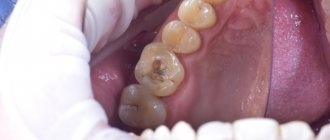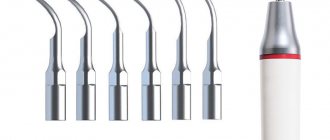Tooth filling is one of the most common and well-established dental procedures, however, it also has its own nuances and subtleties. We tell you what you should pay attention to, what filling to choose and how the filling is installed on a tooth at the ViDentis clinic.
Almost every person has had to deal with a tooth filling in their life. This is a simple and effective procedure, which consists of removing damaged areas of enamel and its further restoration using special compounds. The cost of installing a filling is low, so this treatment is used quite often.
Why do you need dental filling?
The first experiments with the installation of fillings were carried out before our era. Holes in the teeth were filled with resin and various mixtures. However, the archaic technique of filling teeth brought almost no positive results. Fortunately, today everything has changed dramatically. Modern fillings are successfully used to perform a variety of tasks, in particular for:
- functional filling
- aesthetic dental filling
- filling root canals
- temporary sealing of a damaged tooth
Dentists' recommendations
If a tooth is cracked, you can save it, but you should make an appointment with your dentist right away. The sooner professional help is provided, the less likely there are complications.
Before visiting a doctor, you should adhere to the following recommendations:
- the load on the injured tooth is completely eliminated;
- take only soft or ground food of medium temperature;
- Every hour, rinse your mouth with antiseptic agents, saline solutions or herbal decoctions.
Experts strongly advise against touching a damaged tooth with your fingers or tongue. You should not loosen it or try to use any popular recommendations. When a tooth is cracked, it can only be saved by going to the dentist.
Types of dental fillings
Classic filling of carious teeth involves the installation of a dental filling without depulpation of the root canals. This technique is used for minor mechanical and carious damage to the tooth (superficial and medium caries) and is carried out in several stages.
When the dental pulp is damaged, in most cases it is necessary to fill the root canals of the teeth. In the case of milk and young molars, there are methods for preserving the functionality of the root - a biological method of treatment using calcium-containing preparations (tooth filling with calcium) or partial amputation of the pulp. This allows you to maintain the blood supply to the tooth and its vitality, which is especially important when it is in the development stage.
Depulpation involves removing the tooth root, cleaning and developing the canals with special instruments and filling them with artificial materials in order to eliminate the risk of developing inflammatory processes. There are various methods of root canal treatment. There is no absolutely ideal method, so the doctor focuses on a specific clinical case.
Indications and contraindications
Functional filling with aesthetic restoration (or without restoration of aesthetics) is performed:
- in the treatment of carious formations (initial, medium, deep caries);
- in case of damage to the hard tissues of the tooth as a result of injury;
- to replace an old crumbled filling.
Endodontic obturation of root canals is indicated:
- in the treatment of periodontitis, pulpitis (without the possibility of preserving pulp tissue);
- during preparation for prosthetics;
- after removal of the injured dead pulp.
Contraindications to sealing the dental cavity and root canals:
- Acute caries, other inflammatory diseases of the oral cavity.
- Destruction of hard tissues (more than 30%) - prosthetics and dental implantation are recommended.
- Damage to the root system - extraction (removal of a tooth unit) is required.
- Cystic formations.
Relative contraindications to endodontic obturation are longitudinal fracture, root perforation.
Dental filling methods
All methods of filling teeth are based on the use of various materials, which have their own advantages and disadvantages. Therefore, when choosing a technology, the doctor focuses on the individual characteristics of the structure of the root canals and the patient’s body as a whole.
Filling teeth with gutta-percha
Removal of the nerve of the tooth and filling of the canals, when the cavity is filled with a special paste based on gutta-percha with the addition of various impurities. Despite its simplicity and relatively low cost, this method of filling teeth cannot be called reliable and safe. It is often accompanied by a violation of tightness, the development of inflammation and allergic reactions.
Using a pin
Filling a pulpless tooth with pins is one of the most common techniques in dentistry. There are two types of pins (fillers): gutta-percha and metal. Filling tooth canals with gutta-percha is considered a more reliable and safe method. Even taking into account the presence of polymers, dyes and metal salts, such pins are biocompatible and do not cause allergies. Silver metal structures have good flexibility and can be installed in long and curved channels, however, silver is prone to oxidation, which can lead to inflammation. Titanium posts are better in terms of tissue compatibility, but they are very rigid and require the preparation of a special bed, which makes the tooth walls extremely fragile.
Sealers-sealers
Even gutta-percha pins for filling the root canals of teeth by themselves are not able to provide a reliable result, since they do not have antibacterial properties. To improve the quality of filling, dentists use sealers - sealants that ensure a tight fit of the material to the canal walls. There are natural (based on cement, zinc oxide, etc.), polymer sealers, glass ionomer cements and pastes based on calcium hydroxide.
Anesthesia
Filling without anesthesia is possible when treating superficial caries, but even in this case, patients often ask to numb the area. If dental tissues are damaged deeper than the enamel, an anesthetic must be administered.
Types of anesthesia:
- Applique. Used to superficially reduce the sensitivity of tissues. A lidocaine-based spray, gel or ointment is applied to the causative area. The drugs are not absorbed into the blood and act for 20-30 minutes.
- Infiltration. Designed to suppress the sensitivity of the dental nerve and adjacent nerve fibers of the periodontal tissues. The anesthetic is administered by injection and lasts for 1 hour. In some cases, two-stage anesthesia is allowed. The first injection removes the excitability of the nerve endings of the pulp, the second one deprives the tissue of sensitivity.
- Conductor. It is used for deep anesthesia of several units of the dentition at once. The drug is administered not into the site of inflammation, but nearby. It lasts for 2-3 hours.
One of the types of conduction anesthesia is intraligamentous (intraligamentary) anesthesia. In this case, the injection is made with an ultra-thin needle into the periodontal tissue.
Dento-comfort dentists practice all types of pain relief and use safe anesthetics with clinically proven effectiveness.
Teeth filling process
- Initial consultation, taking x-rays.
- Coordination of treatment methods and selection of the type of fillings to be installed.
- Anesthesia before therapeutic intervention (local anesthesia, sedation, in rare cases - general anesthesia).
- Preparation of damaged or caries-affected tooth tissues.
- Grinding and processing the surface of the filling for proper closure.
Filling temporary teeth (baby teeth) follows the same plan, however, in pediatric dentistry, more compatible and safe materials are used.
Filling of anterior teeth
In the case of front teeth, the aesthetic aspect comes to the fore, so the filling material must have the appropriate properties. Although the front teeth receive better hygiene due to their accessibility, they are also susceptible to caries. Installing a filling on the front teeth is considered a more complex procedure: it is necessary not only to give the filling the desired shape, but also to choose the right color. In most cases, filling of anterior teeth is carried out using compomers, as well as light composite fillings, which harden under the influence of ultraviolet radiation. Be that as it may, in case of serious damage, it is impossible to achieve good aesthetics with the help of filling, so you often have to turn to orthopedic solutions.
Proper care
You can find out how much it costs to get a filling in our clinic on the website page. It is necessary to clarify the cost of the service; it is adjusted based on the required size and type of material.
You can extend the life of a restored tooth by following simple recommendations from doctors:
- carry out hygienic cleaning twice a day;
- visit the dentist every six months for professional cleaning of the oral cavity and removal of plaque;
- use interdental brushes and dental floss;
- If you experience pain, injury, or any anxiety, consult a doctor immediately.
It will serve the patient for a long time if he does not ignore the rules of dental care.
Installing a seal on a pin
More recently, it has become common practice in dentistry to install a filling on a post if the tooth is more than 50% destroyed. Thus, the technique made it possible to avoid prosthetics. Filling a tooth with a pin must be preceded by removal of the nerve. Then a special screw is inserted into the root canal and fixed with cement. The procedure is completed by layer-by-layer application of light-polymer composite materials. However, installing a pin does not guarantee reliability and safety. Over time, the cement breaks down, causing microbes to get under the filling, causing the formation of caries. Having chosen modern dentistry to install a filling, you are unlikely to encounter such technology.
What kind of service is this?
Filling refers to the process of removing pathological hard tissues and then filling the cavity with a special material. Fillings allow you to isolate the sensitive part of the tooth and prevent pathogens from entering its cavity.
This dental service may be required in the following cases:
- Deep or moderate carious lesions.
- Trauma to the tooth, which led to damage to the root zone.
- Loss of a previously installed filling.
If you need to make a filling on a tooth, then you need to do the following algorithm of actions:
- Choose a dental clinic.
- Call the company administrator and make an appointment with a specialist.
- Come at the agreed time and discuss filling options with your doctor.
- Wait until the doctor finishes work.
- Pay for the service.
The filling procedure takes place in a number of stages:
- Cleaning the damaged surface from caries.
- Drying saliva in the work area.
- Isolation of the tooth from the surrounding soft tissues with cotton swabs.
- Antimicrobial, mechanical treatment.
- Preparation of filling material.
- Installation.
Filling can take from 20 minutes to an hour . It all depends on the complexity of the work and the technique of its implementation.
Types of filling materials
| Material type | Varieties | Description |
| Cement | – Zinc phosphate – Silicate – Glass ionomer | Currently, of all types of cement fillings, only glass ionomer fillings are actively used, since they provide good mechanical and chemical bonding with tooth tissues. Zinc-phosphate fillings tend to shrink, so they are almost never used when filling teeth for caries. Silicate materials are considered toxic and also have restrictions in their use. |
| Metal | – Gold – Copper – Silver | They are distinguished by high quality and a very large margin of safety. On the other hand, amalgam fillings shrink over time and are not always airtight, which can lead to the development of secondary caries. Due to low aesthetic indicators, they are used for filling chewing teeth. |
| Composite materials | – Acrylic – Epoxy – Light-curing – Chemical-curing | Composite fillings are obtained by mixing organic and inorganic elements. Due to the noticeable disadvantages of filling teeth with composite materials (rapid wear and toxicity for acrylic ones, fragility for epoxy ones), the first two types of fillings are practically not used. Light-curing composites are considered the best: they quickly harden under the influence of ultraviolet radiation and can be used in any part of the jaw. The procedure is often called light dental filling. |
| Compomer | It is a kind of hybrid of glass ionomer and composite | Very aesthetic and high-quality fillings, which are most often used in the frontal region when restoring teeth after chips. Their only drawback is fragility. |
| Materials for temporary fillings | – Artificial dentin – Soft dentin paste – Cariosan (cement) – Vinoxol (zinc oxide based) | They are often placed during pulpitis to check the reaction of the tooth, as well as after filling root canals until a permanent filling is installed. Temporary fillings are also used when filling a tooth under a crown. |
Compomers
Compomer materials are based on photopolymerizable composite and glass ionomer polymers.
The composition is supplemented by:
- strontium fluoride, which strengthens dental tissues;
- silicone dioxide (thickener);
- iron oxide, titanium dioxide, which color the mixture in the color of the enamel.
To harden them, a UV lamp of a certain power is used.
Viscous packable compomers are not strong enough for chewing teeth, so they are recommended for installation in the smile area. Medium creamy and liquid-flowing materials are easy to apply, quickly harden, and are universal for the chewing and frontal parts of the dentition.
How much does the procedure cost?
The exact cost of dental filling is usually announced by the doctor at the initial consultation. The price will depend on the filling material used and the amount of work. Filling canals will cost more than simply installing a filling.
| Type of filling | Price |
| Cement filling | From 900 rubles |
| Glass ionomer filling | From 1,500 rubles |
| Filling made from a light-curing composite of the latest generation | From 3,500 rubles |
| Filling made from a chemocurable composite of the latest generation | From 2,500 rubles |
Possible complications
Sometimes it happens that you have just recently placed a filling, and the tooth reacts to cold, hot, or sour foods. You shouldn’t be alarmed right away - increased sensitivity can persist for several days, after which it goes away on its own. The following symptoms may also appear:
- pain due to the excessive height of the filling (in this case, you need to contact a dentist who will reduce it);
- a sharp electric shock (if the adjacent teeth – upper and lower – have fillings made of different metals);
- traumatization of the tongue or cheeks with sharp edges (which you might not immediately notice due to the action of the anesthetic). In this case, the doctor must re-polish the surface of the tooth.
Allergic reactions to filling materials are very rare. In these cases, the dentist can remove the existing filling and fill the tooth again with a different material.
It is very important to tell your doctor about any reactions your body has to dental treatment. This will help him next time choose other materials or use inlays to reduce tooth sensitivity.










